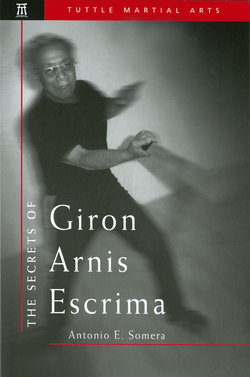Читать книгу Secrets of Giron Arnis Escrima - Antonio Somera - Страница 8
Оглавление▲ Foreword ▲
by Dan Inosanto
It is indeed an honor and a privilege to write this foreword for Grandmaster Leo Giron’s book. Grandmaster Giron is the last living member of a legendary group of martial artists from the Stockton, California Filipino community.
At one time, Stockton had the largest Filipino population in the United States. Because of this Stockton was nicknamed “Little Manila.” The population of Stockton consisted of Filipinos from all over the islands, representing the different ethnicities of the Philippines.
The art of escrima was rarely taught in the Filipino community of Stockton. The Filipino martial arts were highly secretive and all training sessions were closed-door affairs. Many World War II veterans had at least a working knowledge of escrima. Most of them did not teach or share the art with the Filipino community or the general public. The art was held in such high regard that knowledge of it was considered “secured” and quite often the sons, daughters, spouses, etc., had no knowledge of the skill and expertise that existed within their own families.
Grandmaster Giron was one of the first instructors to teach the art of escrima to the Filipino community in northern California, and one of the first to share his knowledge outside of the Filipino Community.
In the late 1960s, I had the honor of training under Grandmaster Giron when very few people knew of the existence of escrima. I found Grandmaster Giron to be a very humble, generous, patient, and giving instructor, both in time and knowledge. One of the highlights of my martial art career occurred on December 26, 1973, when I became the first student to graduate from his system. I truly admire, respect, and love this man. I consider him to be my second father.
Grandmaster Giron brings the rare combination of fighter and teacher to his students. His use of the art in actual combat in the jungles of the Philippines during World War II, displays the effectiveness and usefulness of his methods.
Grandmaster Giron has produced many top level instructors in his system. His fighters competing in the full-contact tournament circuit are some of the best in the United States’ West Coast, and are renowned not only for their fighting tenacity but also for being hard-hitters. The principles and concepts he gave me in his art have allowed me to better understand the many other systems and styles that I later studied. The principles, concepts, and philosophy of the Giron system can be used in the empty-hand arts as well as in the weapon arts.
This book is a tribute to the art and will shed more light on the man and his system. I feel that this book is long overdue, and will be a welcome addition to any martial artist’s library, not only from a technical stand point, but also for it’s historical and cultural value.
